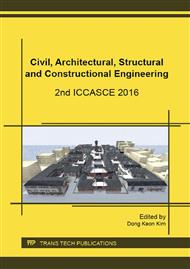p.151
p.157
p.163
p.173
p.179
p.184
p.190
p.196
p.202
Research on Compression Mechanical Properties of Metal-Net Rubber
Abstract:
For the study of the metal-rubber which is a new material used as damper component. The compression mechanical properties of metal-net rubber were studied. Through the static compression test of metal-net rubber, the influence of some factors such as: compression amount, relative density, wire diameter and bearing area. The method is variable-controlling. Experimental results show that along with the increase of the amount of compression, the nonlinear mechanical properties of metal-net rubber boosts; with the increase of relative density, the compressive capacity of metal-net rubber improves. The wire diameter influences the nonlinear mechanical properties of metal-net rubber, the larger the wire diameter, the compressive capacity is higher; the bearing area is greater, the compressive capacity and energy dissipation performance are better.
Info:
Periodical:
Pages:
179-183
Citation:
Online since:
November 2016
Authors:
Price:
Сopyright:
© 2017 Trans Tech Publications Ltd. All Rights Reserved
Share:
Citation:


